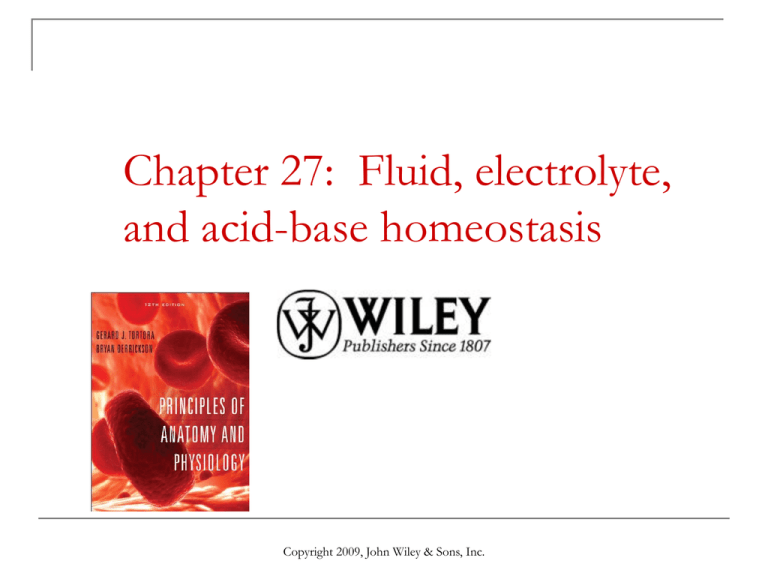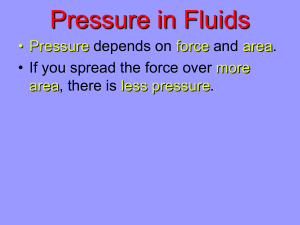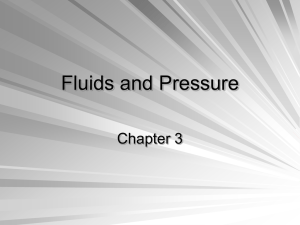
Chapter 27: Fluid, electrolyte,
and acid-base homeostasis
Copyright 2009, John Wiley & Sons, Inc.
Body fluid
all the water and dissolved solutes
in the body’s fluid compartments
Mechanisms regulate
total volume
distribution
concentration of solutes and pH
Regulatory mechanisms insure
homeostasis of body fluids since their
malfunction may seriously endanger
nervous system and organ
functioning.
2
Balance Between Fluid Compartments
About 55%(female) or 60%(male)
of total body mass
Intracellular fluid (ICF) –about 2/3
of body fluid
Extracellular fluid (ECF):
-Interstitial fluid- about 80%
of ECF
- Plasma in blood- about 20%
of ECF
- Also includes lymph, CSF,
synovial fluid, aqueous humor,
vitreous body, endolymph,
perilymph, pleural, pericardial
and peritoneal fluids
Volume of fluid in each is
kept constant. Since water
follows electrolytes, they
must be in balance as
well
Only 2 places for exchange between compartments:
Cell/plasma membranes separate intracellular from interstitial fluid.
only in capillaries are Principles
walls thin
enough
for exchange between plasma
of Human
Anatomy and
3
Physiology, 11e
and interstitial fluids
Fluid Balance
Fluid balance means that the various body compartments contain the
required amount of water, proportioned according to their needs.
Fluid balance = water balance = electrolyte balance → inseparable.
Osmosis is the primary way in which water moves in and out of body
compartments. Solute concentration in the fluids is therefore a major
determinant of fluid balance.
Most solutes in body fluids are electrolytes, compounds that dissociate
into ions.
2 barriers separate ICF, interstitial fluid and plasma
Plasma membrane separates ICF from surrounding interstitial fluid
Blood vessel wall divide interstitial fluid from plasma
Water- largest single component of the body≈ 45-75% of total body mass
Infants have low body fat, low bone mass, and are 73% or more water
Total water content declines throughout life≈ 60%(males) & 50%(females)
Difference due to > body fat & < amount of skeletal muscle in females
In old age, only about 45% of body weight is water
Continual exchange of water and solutes among compartments via
filtration, reabsorption, diffusion, and osmosis
Copyright 2009, John Wiley & Sons, Inc.
Sources of Body Water Gain and Loss
Fluid balance related to electrolyte balance
Intake of water and electrolytes rarely proportional
Kidneys excrete excess water through dilute urine or excess
electrolytes through concentrated urine
Body can gain water by
Ingestion of liquids and moist foods (2300mL/day)
Metabolic synthesis of water during cellular respiration and
dehydration synthesis (200mL/day)
Body loses water through
Kidneys (1500mL/day)
Evaporation from skin (600mL/day)
Exhalation from lungs (300mL/day)
Feces (100mL/day)
Normally loss = gain
Copyright 2009, John Wiley & Sons, Inc.
Daily Water Gain and Loss
Copyright 2009, John Wiley & Sons, Inc.
Regulation of body
water gain
Metabolic water volume depends
mostly on the level of aerobic
cellular respiration, which reflects
the demand for ATP in body cells.
The main way to regulate body
water balance is by adjusting the
volume of water intake.
Dehydration – when water loss is
greater than gain
Decrease in volume, increase
in osmolarity of body fluids
Stimulates
thirst center in
hypothalamus
Regulation of fluid gain is by
regulation of thirst
Copyright 2009, John Wiley & Sons, Inc.
Regulation of water and solute loss
Although increased amounts of water & solutes are lost through sweating &
exhalation during exercise, loss of body water or excess solutes depends
mainly on regulating how much is lost in the urine
Main factor that determines body fluid osmolarity is extent of urinary water
loss
3 hormones regulate renal Na+ and Cl- reabsorption (or not)
ADH(Vasopressin) & Angiotensin II-Aldosterone promote urinary Na+ and
Cl- reabsorption of (and water by osmosis) when dehydrated
Atrial natriuretic peptide (ANP) promotes natriuresis, excretion of Na+ and
Cl- followed by water excretion to decrease blood volume
Major hormone regulating water loss is antidiuretic hormone (ADH)
- stimulates thirst
- increases permeability of principal cells of collecting ducts to assist
in water reabsorption→ very concentrated urine is formed
- ADH secretion shuts off after the intake of water
- ADH secretion is increased when BP drops due to ↓blood volume;
dehydration, vomiting, diarrhea, sweating ….
Copyright 2009, John Wiley & Sons, Inc.
Hormonal Regulation of Blood Osmolality
27-9
Hormonal Regulation of Blood Volume
Hormonal Regulation of Blood Volume
27-11
27_table_01
“water follows salt”
Fluid imbalance between the
intracellular and interstitial fluids
can be caused by a change in
their osmolarity.
Most often a change in
osmolarity is due to change in
Na+ concentration:
Increasing IF osmolarity draws
water out of cells→cells shrink
Decreasing IF osmolarity causes
cells to swell
When water is consumed faster
than the kidneys can excrete it,
water intoxication may result.
Repeated use of enemas can
increase the risk of fluid and
electrolyte imbalances.
Series of Events in
Water Intoxication
ELECTROLYTES IN BODY FLUIDS
Electrolytes serve four general functions in the body.
Because they are more numerous than nonelectrolytes, electrolytes
control the osmosis of water between body compartments.
Maintain the acid-base balance required for normal cellular activities.
Carry electrical current, which allows production of action potentials and
graded potentials and controls secretion of some hormones and
neurotransmitters. Electrical currents are also important during
development.
Serve cofactors needed for optimal activity of enzymes.
Concentration expressed in mEq/liter or milliequivalents per liter for plasma,
interstitial fluid and intracellular fluid
The chief difference between plasma and interstitial fluid is that plasma
contains quite a few protein anions→ blood colloid osmotic pressure
Plasma also contains slightly more sodium ions but fewer chloride ions than
the interstitial fluid.
Principles of Human Anatomy and
Physiology, 11e
15
ICF differs considerably from ECF
ECF most abundant cation is Na+, anion is Cl Sodium
Impulse transmission, muscle contraction, fluid and electrolyte balance
Chloride
Regulating osmotic pressure, forming HCl in gastric acid
Controlled indirectly
by ADH and processes that affect renal
reabsorption of sodium
ICF most abundant cation is K+, anion are proteins and phosphates (HPO42-)
Potassium
Resting membrane potential , action potentials of nerves and muscles
Maintain intracellular volume
Regulation of pH
Controlled by aldosterone
Na+ /K+ pumps play major role in keeping K+ high inside cells and Na+ high
outside cell
Copyright 2009, John Wiley & Sons, Inc.
Regulation of ICF and ECF
Regulation of ECF Volume
Electrolyte and protein anion concentrations
Copyright 2009, John Wiley & Sons, Inc.
Sodium Na+
Most abundant ion in ECF - accounts for 1/2 of osmolarity of ECF
90% of extracellular cations
Plays pivotal role in fluid and electrolyte balance
Level in blood controlled by
Aldosternone – increases renal reabsorption
ADH – if sodium too low, ADH release stops
Atrial natriuretic peptide – increases renal excretion
Excess Na+ in the body can result in edema → generally due to renal failure
& hyperaldosteronemia
Excess loss of Na+ causes excessive loss of water, which results in
hypovolemia, an abnormally low blood volume→ generally due to
inadequate secretion of aldosterone or too many diuretics
Copyright 2009, John Wiley & Sons, Inc.
Chloride Cl
Most prevalent anions in ECF
Moves relatively easily between ECF and ICF because most plasma
membranes contain Cl- leakage channels and transporters
- Passively follows Na+
Can help balance levels of anions in different fluids
- ex. Chloride shift – in RBCs
- plays role in HCl production in stomach
Regulated by
ADH – governs extent of water loss in urine
Processes that increase or decrease renal reabsorption of Na+ also
affect reabsorption of Cl-
Copyright 2009, John Wiley & Sons, Inc.
Potassium K+
Most abundant cation in ICF
Key role in establishing resting membrane potential in neurons
and muscle fibers
Also helps maintain normal ICF fluid volume
Helps regulate pH of body fluids when exchanged for H+
Controlled by aldosterone – stimulates principal cells in renal
collecting ducts to secrete excess K+
Abnormal plasma K+ levels adversely affect cardiac and
neuromuscular function
Copyright 2009, John Wiley & Sons, Inc.
Potassium Ion Regulation in ECF
Bicarbonate HCO3
Second most prevalent extracellular anion
Concentration increases as blood flows through systemic capillaries due
to CO2 released from metabolically active cells
CO2 combines with H2O to form carbonic acid which dissociates
Concentration decreases as blood flows through pulmonary capillaries
and CO2 is exhale
Chloride shift helps maintain correct balance of anions in ECF and ICF
Kidneys are main regulators of blood HCO3 intercalated cells form more HCO3- if levels are too low
excrete excess in the urine
Copyright 2009, John Wiley & Sons, Inc.
Calcium Ca2+
Most abundant mineral in body
99% of calcium in adults in skeleton and teeth – contributes to hardness
In body fluids mainly an extracellular cation
Plays important roles in blood clotting, neurotransmitter release, muscle
tone, and excitability of nervous & muscle tissue
Regulated by parathyroid hormone
Stimulates osteoclasts to release calcium from bone – resorption
Also enhances reabsorption from glomerular filtrate
Increases production of calcitriol to increase absorption for GI tract
Calcitonin lowers blood calcium levels
Copyright 2009, John Wiley & Sons, Inc.
Regulation of Calcium Ions
Phosphate
About 85% in adults present as calcium phosphate salts in bone & teeth
Remaining 15% ionized – H2PO4-, HPO42-, and PO43- are important
intracellular anions
HPO42- important buffer of H+ in body fluids and urine
Same hormones governing calcium homeostasis also regulate HPO42- in
blood
Parathyroid hormone – stimulates resorption of bone by osteoclasts
releasing calcium and phosphate but inhibits reabsorption of phosphate
ions in kidneys
Calcitriol promotes absorption of phosphates and calcium from GI tract
Copyright 2009, John Wiley & Sons, Inc.
Regulation of Blood Phosphate
Regulation of Phosphate Ions
Under normal conditions, reabsorption of phosphate occurs at maximum rate
in the nephron
An increase in plasma phosphate increases amount of phosphate in
nephron beyond that which can be reabsorbed; excess is lost in urine
Magnesium
Second most common intracellular cation
In adults, about 54% of total body magnesium is part of bone as
magnesium salts
Remaining 46% as Mg2+ in ICF (45%) or ECF (1%)
Cofactor for certain enzymes and sodium-potassium pump
Essential for normal neuromuscular activity, synaptic transmission, and
myocardial function
Secretion of parathyroid hormone depends on Mg2+
Regulated in blood plasma by varying rate excreted in urine
Copyright 2009, John Wiley & Sons, Inc.
Regulation of Blood Magnesium
27_table_02
Acid-Base Balance
The overall acid-base balance of the body is maintained by controlling the
H+ concentration of body fluids, especially extracellular fluid.
Homeostasis of H+ concentration is vital
Proteins’ 3-D structure sensitive to pH changes
normal plasma pH must be maintained between 7.35 - 7.45
diet high in proteins tends to acidify the blood
3 major mechanisms to regulate pH
buffer system
exhalation of CO2 (respiratory system)
kidney excretion of H+ (urinary system)
Principles of Human Anatomy and
Physiology, 11e
35
3 Types of Acids in the Body
Volatile acids - Can leave solution and enter the atmosphere
Carbonic acid is an important volatile acid in body fluid
Fixed acids - Are acids that do not leave solution. Once produced they
remain in body fluids until eliminated by kidneys
Sulfuric Acid and Phosphoric Acid are most important fixed acids in
the body generated during catabolism of AA’s, phospholipids, &
nucleic acids
Organic acids :
Produced by aerobic metabolism are metabolized rapidly & do not
accumulate
Produced by anaerobic metabolism (e.g., lactic acid) build up rapidly
Buffer systems
Act to quickly temporarily bind H+
Raise pH but do not remove H+
Most consist of weak acid and salt of that acid functioning as weak base
Change either strong acid or base into weaker one
Work in fractions of a second
Found in fluids of the body
3 principal buffer systems
protein buffer system
carbonic acid-bicarbonate buffer system
phosphate buffer system
Copyright 2009, John Wiley & Sons, Inc.
Regulation of Acid-Base Balance
Regulation of Acid-Base Balance
27-40
Buffer Systems
Buffer systems
Protein buffer system - Most abundant buffer in ICF & blood plasma
Hemoglobin in RBCs & Albumin in blood plasma
Hemoglobin acts as a buffer in blood by picking up CO2 or H
Free carboxyl group acts like an acid by releasing H+
Free amino group acts as a base to combine with H+
Side chain groups on 7 of 20 amino acids also can buffer H+
Copyright 2009, John Wiley & Sons, Inc.
Buffer Systems
Carbonic acid / bicarbonate buffer system
Based on bicarbonate ion (HCO3-) acting as weak base &
carbonic acid (H2CO3) acting as weak acid
HCO3- is a significant anion in both ICF and ECF
Because CO2 and H2O combine to form this buffer system cannot
protect against pH changes due to respiratory problems in which there is
an excess or shortage of CO2
Copyright 2009, John Wiley & Sons, Inc.
Buffer Systems
Phosphate buffer system
Dihydrogen phosphate (H2PO4-) and monohydrogen phosphate
(HPO42-)
Phosphates are major anions in ICF and minor ones in ECF
Important regulator of pH in cytosol but also acts to buffer acids in
urine
Copyright 2009, John Wiley & Sons, Inc.
Exhalation of carbon dioxide
The pH of body fluids may be adjusted by a change in the rate & depth of
respirations, which usually takes from 1 to 3 minutes
Increase in the rate & depth of breathing = more CO2 exhaled = ↑ blood pH.
Decrease in respiration rate & depth= less CO2 exhaled = ↓blood pH .
The pH of body fluids, in turn, affects the rate of breathing
Increase in carbon dioxide in body fluids lowers pH of body fluids
The kidneys excrete H+ and reabsorb HCO3- to aid in maintaining pH.
Because H2CO3 can be eliminated by exhaling CO2 it is called a volatile
acid
Copyright 2009, John Wiley & Sons, Inc.
Regulation of blood pH by the respiratory system
pH modified by changing rate &
depth of breathing:
faster breathing rate, blood pH
rises
slow breathing rate, blood pH
drops
H+ detected by chemoreceptors
in medulla oblongata, carotid &
aortic bodies
Respiratory centers inhibited or
stimulated by changes is pH
Copyright 2009, John Wiley & Sons, Inc.
Respiratory Regulation of Acid-Base Balance
27-47
Kidney Regulation of Acid-Base Balance
Kidney Excretion of H+
Metabolic reactions produce 1mEq/liter
of nonvolatile acid/kg BW
Excretion of H+ in the urine is only way
to eliminate huge excess
In the PCT, Na+/H+ antiporters secrete
H+ as they reabsorb Na+
Intercalated cells of collecting duct
include proton pumps→ secrete H+ into
tubule fluid; reabsorb K+ & HCO3Urine can be up to 1000 times more
acidic than blood
Kidneys synthesize new bicarbonate
and save filtered bicarbonate
Renal failure can cause death rapidly
due to its role in pH balance
2 other buffers can combine with H+ in
collecting duct:
- HPO42- and NH3
49
Hydrogen Ion Buffering
Regulation of Acid-Base Balance
Cells in the PCT and collecting ducts secrete H+ into the tubular fluid.
In the PCT Na+/H+ antiporters secrete H+ and reabsorb Na+
The apical surfaces of some intercalated cells include proton pumps (H+
ATPases) that secrete H+ into the tubular fluid and HCO3– antiporters in
their basolateral membranes to reabsorb HCO3–
Other intercalated cells have proton pumps in their basolateral membranes
and Cl–/HCO3– antiporters in their apical membranes.
These two types of cells help maintain body fluid pH by excreting excess
H+ when pH is too low or by excreting excess HCO3– when the pH is too
high.
Normal pH range of arterial blood 7.35-7.45
Acidosis – blood pH below 7.35 ; Alkalosis – blood pH above 7.45
Major physiological effect of :
Acidosis – depression of synaptic transmission in CNS
Alkalosis – overexcitability of CNS and peripheral nerves
Principles of Human Anatomy and
Physiology, 11e
51
27_table_03
Physiological responses to normalize arterial blood pH
Changes in blood pH may be countered by compensation
Complete – brought within normal range
Partial – still too low or high
Respiratory compensation – hyperventilation or hypoventilation
Renal compensation – secretion of H+ and reabsorption of HCO3Respiratory acidosis / alkalosis are primary disorders of blood PCO2.
Metabolic acidosis/alkalosis are primary disorders of HCO3- concentration
Copyright 2009, John Wiley & Sons, Inc.
Respiratory acidosis
Abnormally high PCO2 in systemic arterial blood
Inadequate exhalation of CO2
Any condition that decreases movement of CO2 out – emphysema,
pulmonary edema, airway obstruction
Kidneys can help raise blood pH
Goal to increase exhalation of CO2 – ventilation therapy
Respiratory Alkalosis
- Abnormally low PCO2 in systemic arterial blood
Cause is hyperventilation due to O2 deficiency from high altitude
or pulmonary disease, stroke, severe anxiety, aspirin overdose
Renal compensation involves decrease in excretion of H+ and increase
reabsorption of bicarbonate
- One simple treatment to breathe into paper bag for short time
Copyright 2009, John Wiley & Sons, Inc.
Metabolic Acidosis
Results from changes in HCO3- concentration
Metabolic acidosis – abnormally low HCO3- in systemic arterial blood
Loss of HCO3- from severe diarrhea or renal dysfunction
Accumulation of acid (ketosis with dieting/diabetes)
Kidney failing to remove H+ from protein metabolism
Respiratory compensation by hyperventilation
Administer IV sodium bicarbonate and correct cause of acidosis
Metabolic Alkalosis
Abnormally high HCO3- in systemic arterial blood
Non-respiratory cause: vomiting acidic stomach contents, gastric suctioning
Excessive intake of alkaline drugs (antacids) & use of certain diuretics
Severe dehydration
Respiratory compensation is hypoventilation
Give fluid solutions to correct Cl-, K+ and other electrolyte deficiencies
and correct cause of alkalosis
Copyright 2009, John Wiley & Sons, Inc.
27_table_04
Diagnostic Chart for Acid-Base Disorders
Figure 27–15 (1 of 2)
Copyright 2009, John Wiley & Sons, Inc.
Diagnosis of Acid-Base Imbalances
Evaluate
systemic arterial blood pH
concentration of bicarbonate (too low or too high)
PCO2 (too low or too high)
Solutions
if problem is respiratory, the pCO2 will not be normal
if problem is metabolic, the bicarbonate level will not be normal
Principles of Human Anatomy and
Physiology, 11e
59
End of Chapter 27
Copyright 2009 John Wiley & Sons, Inc.
All rights reserved. Reproduction or translation of this
work beyond that permitted in section 117 of the 1976
United States Copyright Act without express
permission of the copyright owner is unlawful.
Request for further information should be addressed to
the Permission Department, John Wiley & Sons, Inc.
The purchaser may make back-up copies for his/her
own use only and not for distribution or resale. The
Publishers assumes no responsibility for errors,
omissions, or damages caused by the use of theses
programs or from the use of the information herein.
Copyright 2009, John Wiley & Sons, Inc.







